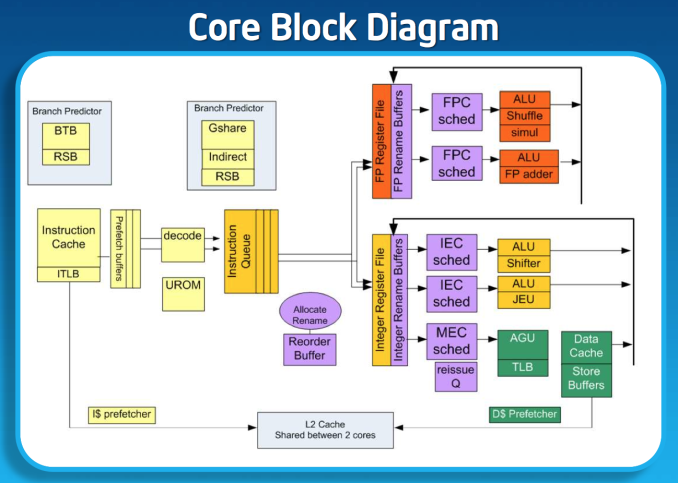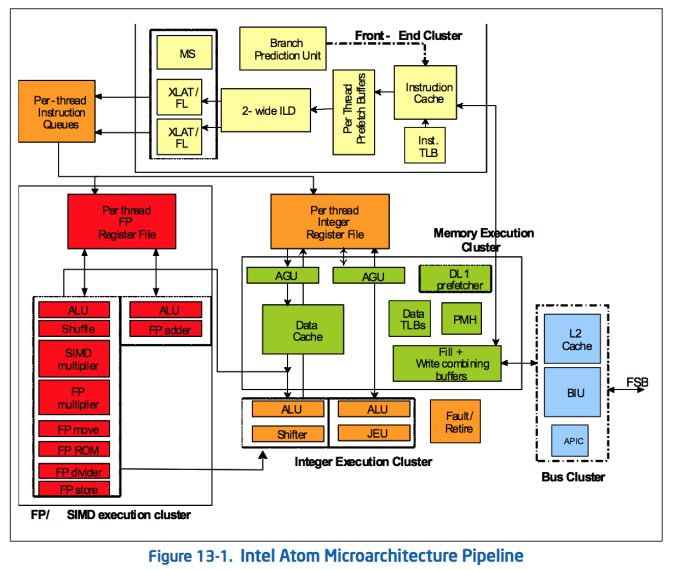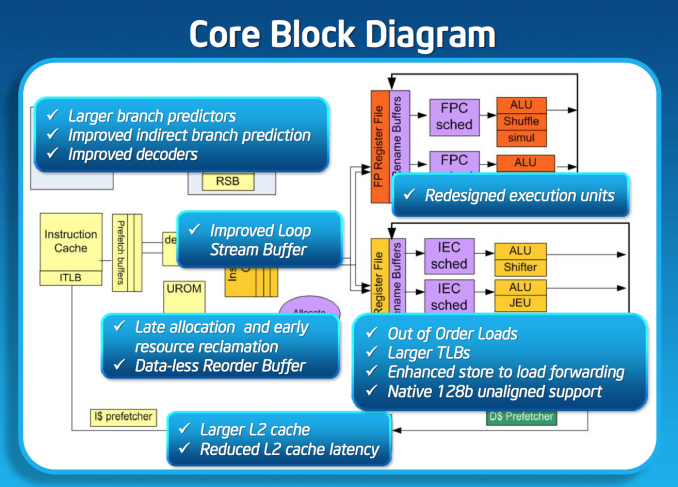Intel’s Silvermont Architecture Revealed: Getting Serious About Mobile
by Anand Lal Shimpi on May 6, 2013 1:00 PM EST- Posted in
- CPUs
- Intel
- Silvermont
- SoCs
Sensible Scaling: OoO Atom Remains Dual-Issue
The architectural progression from Apple, ARM and Qualcomm have all been towards wider, out-of-order cores, to varying degrees. With Swift and Krait, Apple and Qualcomm both went wider. From Cortex A8 to A9 ARM went OoO and then from A9 to A15 ARM introduced a significantly wider architecture. Intel bucks the trend a bit by keeping the overall machine width unchanged with Silvermont. This is still a 2-wide architecture.
At the risk of oversimplifying the decision here, Intel had to weigh die area, power consumption as well as the risk of making Atom too good when it made the decision to keep Silvermont’s design width the same as Bonnell. A wider front end would require a wider execution engine, and Intel believed it didn’t need to go that far (yet) in order to deliver really good performance.
Keeping in mind that Intel’s Bonnell core is already faster than ARM’s Cortex A9 and Qualcomm’s Krait 200, if Intel could get significant gains out of Silvermont without going wider - why not? And that’s exactly what’s happened here.
If I had to describe Intel’s design philosophy with Silvermont it would be sensible scaling. We’ve seen this from Apple with Swift, and from Qualcomm with the Krait 200 to Krait 300 transition. Remember the design rule put in place back with the original Atom: for every 2% increase in performance, the Atom architects could at most increase power by 1%. In other words, performance can go up, but performance per watt cannot go down. Silvermont maintains that design philosophy, and I think I have some idea of how.
Previous versions of Atom used Hyper Threading to get good utilization of execution resources. Hyper Threading had a power penalty associated with it, but the performance uplift was enough to justify it. At 22nm, Intel had enough die area (thanks to transistor scaling) to just add in more cores rather than rely on HT for better threaded performance so Hyper Threading was out. The power savings Intel got from getting rid of Hyper Threading were then allocated to making Silvermont an out-of-order design, which in turn helped drive up efficient use of the execution resources without HT. It turns out that at 22nm the die area Intel would’ve spent on enabling HT was roughly the same as Silvermont’s re-order buffer and OoO logic, so there wasn’t even an area penalty for the move.
The Original Atom microarchitecture
Remaining a 2-wide architecture is a bit misleading as the combination of the x86 ISA and treating many x86 ops as single operations down the pipe made Atom physically wider than its block diagram would otherwise lead you to believe. Remember that with the first version of Atom, Intel enabled the treatment of load-op-store and load-op-execute instructions as single operations post decode. Instead of these instruction combinations decoding into multiple micro-ops, they are handled like single operations throughout the entire pipeline. This continues to be true in Silvermont, so the advantage remains (it also helps explain why Intel’s 2-wide architecture can deliver comparable IPC to ARM’s 3-wide Cortex A15).
While Silvermont still only has two x86 decoders at the front end of the pipeline, the decoders are more capable. While many x86 instructions will decode directly into a single micro-op, some more complex instructions require microcode assist and can’t go through the simple decode paths. With Silvermont, Intel beefed up the simple decoders to be able to handle more (not all) microcoded instructions.
Silvermont includes a loop stream buffer that can be used to clock gate fetch and decode logic in the event that the processor detects it’s executing the same instructions in a loop.
Execution
Silvermont’s execution core looks similar to Bonnell before it, but obviously now the design supports out-of-order execution. Silvermont’s execution units have been redesigned to be lower latency. Some FP operations are now quicker, as well as integer multiplies.
Loads can execute out of order. Don’t be fooled by the block diagram, Silvermont can issue one load and one store in parallel.













174 Comments
View All Comments
MelodyRamos47 - Sunday, May 12, 2013 - link
If you think Emma`s story is super..., a month back father in-law also earned $6677 putting in from there apartment and their roomate's step-sister`s neighbour has done this for 6 months and easily made more than $6677 in their spare time from a labtop. applie the information on this link, Bow6.comCHECK IT OUTsamda - Monday, May 13, 2013 - link
I signed up here just to post this and show just how objective Anand really is."It will be insane if Silvermont reaches the 2010 MacBook Air "
Well what a load of biased ignorance.
Mr. Anand, you might want to read this and learn a bit:
http://browser.primatelabs.com/geekbench2/1946978
http://browser.primatelabs.com/geekbench2/1947269
Galaxy S4 ALREADY being there, heck even beating it easily!
Can you imagine what will a 2Ghz Octa do?
With this kind of memory? http://m.androidauthority.com/samsung-lpddr3-ram-2...
How about Snapdragon 800?
But yeah, it seems someone is being too busy sucking on Intel and living in the past!
etre - Monday, May 13, 2013 - link
Still Intel is not really trying on this market. They moved up from a 2008 design to a 2010 design on a last year process. And it took them 5 years to do that.They should have offered Haswell kind of tech, with the improvements on memory, this summer, at a killer price.
Why should I support Intel by buying an Asus Phonepad, on a promise that they will bring something sometime, instead of going for a sure bet with the new Nexus 7 and quad core Krait.
CodyCostaRica - Monday, May 20, 2013 - link
Anand,Thanks so much for this article. I would be highly interested in knowing how Intel's current and future chip road maps stack up against the competitors' current and future offerings in the mobile space (Qualcomm, NVIDIA, Samsung, Apple).
For example, how does Silvermont compare to the Apple A6X, currently used in the latest iPad?
Keep up the good work!